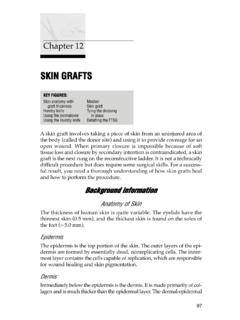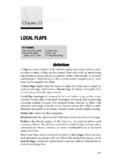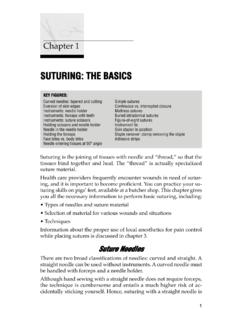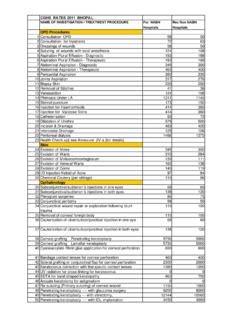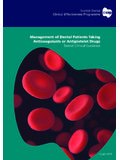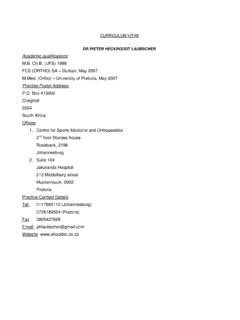Transcription of SCAR FORMATION - Practical Plastic Surgery
1 Chapter 15. SCAR FORMATION . KEY FIGURES: Hypertrophic scar Buried dermal suture This chapter gives background information about the scarring process. Treatment options for problematic scars are also discussed. Normal Course of Scar Maturation Strength Scar tissue is never as strong as normal, uninjured skin. For the first 3 4 weeks after injury, the wound can easily be reopened by minimal trauma. By 6 weeks, the scar has attained approximately 50% of its final strength. During the next 12 months, the scar gradually increases its ability to withstand injury, but it never attains normal strength. Appearance The period of maximal collagen production (the primary component of skin and scar tissue) is the first 4 6 weeks after a wound has closed.
2 During this period the scar may appear red and be slightly firm and raised. Over the next several months, changes in the rate of collagen produc- tion and degradation occur. Normal healing results in normal types and amounts of collagen in the area. On the surface, normal healing is illustrated by the fading of redness and softening of the scar. I usually tell patients that it will take at least 1 year for the scar to achieve its final appearance. scars in children may continue to change and improve for several years. 137. 138 Practical Plastic Surgery for Nonsurgeons Abnormal Scarring For various reasons, such as genetics, nature of initial injury, or bad luck, some scars become exceptionally red, thick, and tight. Such scars can be problematic on the hand or other flexor surfaces, because they may lead to limitation of movement and loss of function.
3 Hypertrophic scars are a bit thicker and redder than the fine scar that usually results after primary healing. At the extreme, scars may become keloids that is, they may enlarge beyond their initial area. Keloids can become large and unsightly. They also can cause annoying symptoms, such as itching and pain. Typical hypertrophic scar. Note that the scar is thick and raised but still within the confines of a normal scar. In addition, the scar may be unstable. An unstable scar is easily rein- jured with minimal trauma; it heals but is easily injured again. This cycle can go on for years and ultimately result in the development of an aggressive form of skin cancer. Abnormal scarring is usually the result of abnormal collagen produc- tion and degradation.
4 Although we do not know the exact cause of these abnormal processes, the manner in which a wound is closed may play a role. In addition, there are interventions that can improve an ab- normal scar. Scar FORMATION 139. Method of Wound Closure Primary Wound Closure Usually, the best ( , least noticeable) scar results when a wound is closed by suturing the skin edges together. Usually the sutures are re- moved before the 14th day after repair. As explained above, at this point the scar is not very strong; in fact, it has < 15% of its final strength. Normal everyday movements will pull on the scar and may result in widening of the scar. For this reason, most Plastic surgeons place buried dermal sutures as well as the usual skin sutures when they close a wound (see figure below).
5 Buried dermal sutures are not difficult to place, but this extra step is time-consuming. The dermal sutures add strength to the repair site during the weeks to months required for their absorption. The anticipated result is less widening and an improved appearance of the scar. Buried dermal sutures are used to hold together the skin edges and thereby de- crease tension on the external sutures. In theory, placement of a few buried dermal sutures decreases the risk for hypertrophic scarring and keloid FORMATION . When dermal sutures are not used, be sure that the skin sutures pro- vide good dermis-to-dermis approximation. It also is important to remove the sutures at the appropriate time (see chapter 1, suturing : The Basics ).
6 Sutures that are left in place too long cause an inflamma- tory response that worsens scar appearance. If Steristrips are available, put them across the suture line when the su- tures are removed. This simple step gives the scar a bit of extra strength during the period when it is vulnerable to injury. Secondary Wound Closure Wounds that are allowed to heal secondarily often have larger, more noticeable scars than ones closed primarily. Secondary wound closure 140 Practical Plastic Surgery for Nonsurgeons also is associated with a higher incidence of hypertrophic scarring and keloid FORMATION . How the Patient Can Help Once the sutures have been removed and the wound looks well healed, rubbing or gently massaging the scar with a mild moisturizing cream ( , Vaseline, aloe, cocoa butter) a few times each day promotes softening and lightening of scar tissue, especially on the face and hands.
7 A cream with vitamin E may be helpful. Patients should not spend a large sum of money on fancy creams because no conclusive evidence indicates that ex- pensive formulations improve the scar's final appearance. Gentle massage should be continued for at least 4 6 weeks. Patients should stay out of the sun as much as possible, and always use a sunscreen (SPF > 20). scars exposed to the sun (especially if sunburn dvelops) not only stay red longer but also may not fade as much as normally expected. All patients should maintain good nutrition, and diabetics should maintain good glucose control. Providers must counsel patients aggressively about the ill effects of tobacco products on wound healing. Some of the components in ciga- rettes cause a decrease in blood circulation to the skin, which results in poor wound healing and may even lead to tissue loss.
8 Dramatic ad- verse reactions due to the effects of smoking have been reported. Interventions for Problematic scars scars that are Too Tight These treatments can be tried individually or in some combination. Gentle Massage Instruct the patient in the massage techniques described above. Silicone Gel Sheets Once the sutures have been removed and the wound looks well healed, you can cover the wound with silicone gel sheets. Although it is not entirely understood how they work, silicone gel sheets can be quite effective. They can be obtained from pharmacies but usually re- quire a prescription (although this policy is changing in the United States). Scar FORMATION 141. How to use the silicone gel sheet 1. Cut a piece large enough to cover the scar completely.
9 2. The sheet should be left in place as long as tolerated even all day. The longer it is in place, the better. 3. The patient should remove the sheet to wash. Deodorant soaps should not be used to cleanse the area; they may cause a rash. One piece of gel sheet can be used repeatedly. 4. Sheets should be used for at least 2 3 months to make an apprecia- ble difference. Splinting The purpose of splinting is to prevent loss of function and restriction of movement from a tight scar. Especially on the hand and in a crease, splinting can be quite useful. The splint should be molded so that it stretches the tight scar. Case example: If a tight scar across the front of elbow prevents the pa- tient from fully extending the forearm, the following steps may help: Make a splint that holds the elbow in as much extension as tolerated.
10 Gradually the scar will become less tight because of the remodeling due to splinting and scar massage (remember, you can add other scar is too tight treatments). With time the patient will be able to extend the elbow more fully. The splint can be made out of simple plaster of Paris (see chapter 28, Hand Splinting and General Aftercare ). If the splint interferes with the patient's ability to work, encourage the patient to wear it at night. New splints should be made as the patient can more fully extend at the elbow. This process may take many months, but is worth the effort to im- prove function. Pressure Garments Pressure garments, measured and fitted to the individual patient, can be worn under everyday clothing. They are designed to apply continu- ous pressure over the area of concern.


